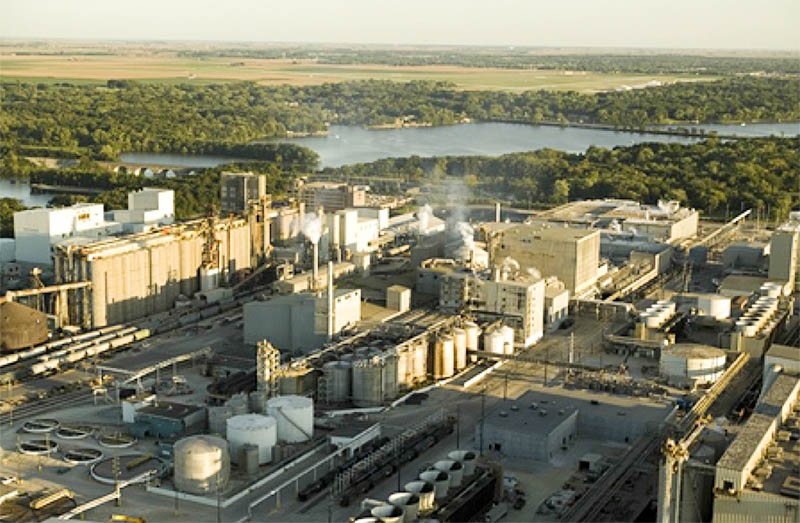By Bryce Gray
325 parts per million in 1970… 350 ppm in 1988… 400 ppm in 2015…
At 400 ppm, atmospheric carbon dioxide levels are now nearly 40 percent higher than in pre-industrial times and are higher than they have been in more than 800,000 years. As the global concentration of CO2 climbs ever higher and holds more heat around the Earth, scientists continue to devise strategies that might slow the accumulation of the greenhouse gas.
One technique with strong potential for climate change mitigation is carbon capture and sequestration, or storage. This process, or CCS for short, is being put to the test in Decatur where 1 million tons of carbon dioxide from an ethanol plant have been pumped 7,000 feet below ground.
Known as the Illinois Basin-Decatur Project, the initiative completed a three-year carbon dioxide test injection process late last year. Now they are monitoring the process to see if any of the gas escapes. The project is a collaborative effort of Archer Daniels Midland – the operator of the ethanol plant – and the Midwest Geological Sequestration Consortium.

The Decatur site was chosen because of the underlying Mount Simon Sandstone formation – a porous rock layer that extends beneath Illinois, western Indiana and western Kentucky.
“Sandstone is rock that’s made of sand,” said Sallie Greenberg, sequestration communications coordinator for the MGSC and the Illinois State Geological Survey. “All of those grains of sand touch each other, but it’s not completely solid. On a macro scale, if you think about a crate of oranges, there’s sort of big, hourglass spaces between them and that space is called pore space.”
That pore space has become the destination for CO2 funneled below ground. Besides its depth and porosity, Greenberg said that several other factors make the Mount Simon formation ideally suited for CCS projects.
”There are no hydrocarbons present in the Mount Simon Sandstone, which means that it has very few well bores, so it’s relatively pristine,” said Greenberg. “And by that, I mean that it doesn’t have a lot of potential manmade, anthropogenic leakage pathways.”
The prospect of leakage should also be thwarted by the presence of the overhead Eau Claire Shale deposit, which serves as an impermeable caprock for added security.
“The Mount Simon Sandstone at Decatur is 1,500 feet thick, and we’re injecting at the bottom,” said Greenberg. “For CO2 to migrate upward, our models show after 500 years that it doesn’t come anywhere close to hitting that impermeable rock unit above.”
“When you inject CO2 into that rock, what happens is that the CO2 goes into the brine. Some of it dissolves into the brine, like carbon dioxide in a can of soda, and some of it exists as liquid CO2 in those pore spaces.”
– Sallie Greenberg, ISGS
Confidence in the formation’s retention ability was echoed by Douglas Brauer, an administrator at Richland Community College in Decatur, which is home to the National Sequestration Education Center.
Brauer, who has a background in industrial engineering, characterized the injection zone as an “ideal area for containment.”
“The area that caps this is very thick and very dense rock,” Brauer said. “It ends up being a very natural spot for this to be done safely.”
A common misconception about CCS is that CO2 is put in the ground in a gaseous state, but it is actually converted into a liquid because of the pressurized conditions under which it is injected and stored.
“At 7,000 feet, those pore spaces have brine in them – salty water that’s probably six times saltier than the ocean,” said Greenberg. “When you inject CO2 into that rock, what happens is that the CO2 goes into the brine. Some of it dissolves into the brine, like carbon dioxide in a can of soda, and some of it exists as liquid CO2 in those pore spaces.”
Depending on the geochemistry of the water, Greenberg said that, without any leakage pathways, most of the CO2 will undergo mineralization and form new rock in the long run.
“We see absolutely no evidence that there is any leakage or potential of leakage from the Mount Simon Sandstone.”
– Sallie Greenberg, ISGS
For now, however, the Decatur project is entering a three-year post-injection monitoring phase, where scientists will track the injected CO2 to ensure that it stays locked away. If it does, the Mount Simon Sandstone formation and its estimated storage capacity of 11 to 150 billion tons of CO2 could become the home of many more CCS projects in the future. So far, the signs are encouraging. That’s enough storage to sequester about 50 to 670 years of Illinois’ annual CO2 output, depending on the storage capacity.
“We see absolutely no evidence that there is any leakage or potential of leakage from the Mount Simon Sandstone,” said Greenberg.
Hopes that CCS could emerge as an environmental savior are tempered by the current lack of economic incentive for CO2 emitters to engage in the process.
“For it to really take off, there needs to be some kind of policy or economic driver for that the really happen” Greenberg said, alluding to measures such as a carbon tax or trading scheme with carbon credits.
“Really what’s going to drive CCS forward is it’s perceived as a necessary component of protecting the environment.”


